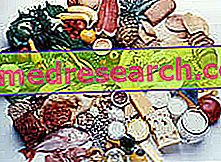By Dr. Elisa Sanna
Food groups
The different foods and foods we eat every day with diet and nutrition have a peculiar composition in terms of nutrients; this allows them to be characterized and then divided into the so-called "FOOD GROUPS" or categories.

The groups are therefore not so fiscal, and certainly the subject will require further study. Let's start with the basics.
Protein Foods
The main protein foods belong to the sphere of zootechnical productions, therefore we find RED MEAT (such as beef, pork, horse and sheep-goat products) and WHITE MEAT (chicken, turkey), but also derived CHEESE and LACTICIANS and the eggs. With regard to the latter, we must distinguish between egg white or light, a source of protein only, and the yolk, which contains animal fats and cholesterol in high proportion.
Even fish and molluscs have a high protein content, of biological value comparable to that of meat, if not higher, in some cases. However, their protein density is lower. The case of vegetable proteins is different, as they have a lower biological value than those of animal origin and must be integrated with each other.
Glucid Foods
Carbohydrates are divided into "simple" and "complex" depending on the number of molecules they are made of. The complex carbohydrates, of vegetable origin, are starches and fibers and are found, for example, in cereals, tubers, vegetables, legumes and seeds. Glycogen is a complex sugar found in animal tissues. The main simple carbohydrates (or simple sugars) are Glucose (present in the blood) Fructose (present in fruit and vegetables), sucrose and lactose (sugar contained in milk and its derivatives).
Food oils and fats
It is necessary to make a double distinction; the first concerns consistency. The term OLI is usually used to indicate liquid fats such as olive oil, while the term GRASSI refers to solid fats, such as butter and margarine.
Depending on the origin we also distinguish vegetable and animal fats.
Finally, they remain, not least in importance but only for their percentage content, clearly lower than that of the macronutrients treated so far, the MICRONUTRIENTS. These are represented by Vitamins and Minerals otherwise distributed in every food present in the groups, the speech is therefore very articulated and deserves a deepening that goes beyond the intentions of this article.



